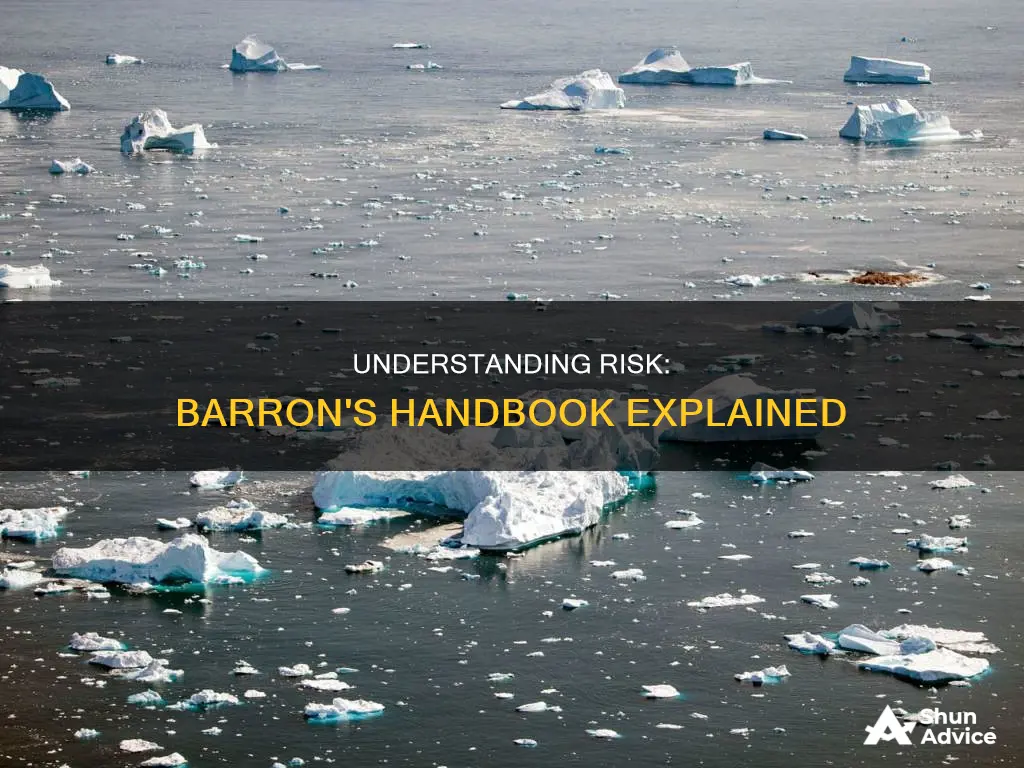
Barron's Finance & Investment Handbook is a comprehensive reference book for investors, providing a financial dictionary, analysis of investment opportunities, and explanations of corporate reports and financial news. While the book does not explicitly define risk, it offers tools to help investors understand and manage it. The handbook includes a section on risk diversification, which is a strategy to minimize risk by investing in diverse industries and assets. It also covers different types of financial risk, such as market, credit, liquidity, and operational risk, helping investors identify and navigate potential challenges in their investment decisions.
What You'll Learn

Risk and Time Horizons
Time horizon and liquidity of investments are key factors influencing risk assessment and management. An investor's time horizon is the length of time they have to invest and achieve their financial goals. This is often linked to an individual's age and life stage. For example, younger investors with longer time horizons until retirement may be willing to take on more risk in pursuit of higher returns, whereas older investors may have a shorter time horizon and thus require funds to be more readily available, leading to a lower risk tolerance.
The time horizon of an investment is an important consideration for risk management. If an investor needs immediate access to their funds, they are less likely to invest in high-risk or illiquid assets. Riskless securities, such as certificates of deposits, government money market accounts, and U.S. Treasury bills, are often favoured in these cases as they offer a baseline level of risk and return.
On the other hand, investors with a longer time horizon may be more willing to invest in higher-risk investments, as they can afford to ride out short-term market volatility and focus on long-term growth. These investors can also take advantage of compound interest, which can help to offset some of the risks associated with volatile investments.
Additionally, the time horizon of an investment can impact the types of risks faced. For example, political risk, or the risk of a change in government or foreign policy, becomes more of a factor as the investment's time horizon increases. This is because longer-term investments are more likely to be affected by changes in the political landscape.
In summary, time horizon is a critical factor in risk assessment and management. It influences the types of investments individuals are willing to make, the level of risk they are comfortable with, and the potential returns they can expect. By carefully considering their time horizon, investors can make more informed decisions about their investment strategies and better manage the risks associated with their financial goals.
Private Equity: Minimum Investment Requirements Explained
You may want to see also

Types of Financial Risk
Barron's Finance and Investment Handbook does not appear to define risk explicitly. However, the concept of risk is central to investing and financial management.
Systematic Risk
Systematic risks, also known as market risks, have the potential to affect an entire economic market or a large portion of it. Political risk, macroeconomic risk, interest rate risk, inflation risk, currency risk, liquidity risk, and country risk are examples of common types of systematic risk. Market risk is challenging to mitigate through portfolio diversification.
Unsystematic Risk
Unsystematic risk, also referred to as specific or idiosyncratic risk, pertains to the possibility of losing an investment due to company- or industry-specific hazards. Changes in management, product recalls, new competition, and regulatory changes are examples of unsystematic risks that impact a particular company or industry. Diversification is a strategy used by investors to manage this type of risk.
Business Risk
Business risk relates to the fundamental viability of a business. It considers whether a company can generate sufficient sales and revenue to cover operational expenses and turn a profit. Factors such as the cost of goods, profit margins, competition, and demand for the company's products or services influence its level of business risk.
Operational Risk
Operational risk is a subset of business risk that arises from the day-to-day operations of a company. It includes risks associated with system failures, human errors, fraud, or other internal processes that could negatively impact the financial performance of the business. Effective internal controls, processes, and systems can help manage operational risks.
Legal and Regulatory Risk
Businesses and investments are exposed to legal risks stemming from changes in laws and regulations or legal disputes. Compliance programs, monitoring regulatory changes, and seeking legal advice can help mitigate these risks.
Credit or Default Risk
Credit risk is the possibility that a borrower will be unable to meet their debt obligations. This type of risk is particularly relevant for investors holding bonds. Government bonds are generally considered low-risk, while corporate bonds have a higher chance of default but offer higher interest rates.
Country Risk
Country risk refers to the possibility that a country will be unable to honour its financial commitments. This type of risk can impact the performance of financial instruments within that country and those of its trading partners. Country risk is often observed in emerging markets or countries with severe deficits.
Foreign-Exchange Risk
Foreign-exchange risk, or exchange rate risk, applies to financial instruments denominated in a currency other than the domestic currency. Changes in currency exchange rates can affect the price of the asset.
Interest Rate Risk
Interest rate risk is the possibility that an investment's value will fluctuate due to changes in interest rates or the shape of the yield curve. This type of risk has a more direct impact on bonds than stocks and is significant for all bondholders.
Reinvestment Risk
Reinvestment risk is related to interest rate risk and refers to the possibility that an investor may not be able to reinvest cash flows from an investment (such as interest or dividends) at the same rate of return as the original investment.
Political Risk
Political risk refers to the possibility that an investment's returns could suffer due to political instability or changes in a country. This risk becomes more significant as the investment's time horizon lengthens.
Counterparty Risk
Counterparty risk is the likelihood that one party in a transaction might default on its contractual obligations. It is relevant in credit, investment, and trading transactions, especially in over-the-counter (OTC) markets.
Liquidity Risk
Liquidity risk is associated with an investor's ability to convert their investment into cash. Illiquid assets typically require a premium to compensate investors for the difficulty of liquidating them.
Model Risk
Model risk arises from the use of financial models for decision-making, risk evaluation, or pricing financial instruments. It occurs when models are based on incorrect assumptions, data, or methodologies, leading to inaccurate predictions and potential financial losses.
UK Investment Strategies: A Beginner's Guide to Getting Started
You may want to see also

Risk and Diversification
Risk is defined in financial terms as the chance that an investment's actual gains will differ from an expected outcome or return. Risk includes the possibility of losing some or all of an original investment. In other words, it is the likelihood that an investment will not perform as expected.
Risk can be broadly categorised into two types: systematic risk and unsystematic risk. Systematic risk, also known as market risk, affects the entire economic market or a large percentage of it. It includes factors such as political risk, macroeconomic risk, interest rate risk, inflation risk, currency risk, liquidity risk, country risk, and sociopolitical risk. On the other hand, unsystematic risk is specific to a particular industry or company and includes factors like changes in management, product recalls, regulatory changes, or new competitors.
One of the most effective strategies for minimising risk is diversification. A well-diversified portfolio consists of different types of securities from diverse industries, with varying degrees of risk and correlation. By spreading investments across multiple assets, investors can reduce the impact of unsystematic risk. However, it's important to note that diversification cannot protect against systematic risks, which require other risk management strategies.
There are several ways to ensure adequate diversification:
- Invest in multiple investment vehicles such as cash, stocks, bonds, mutual funds, ETFs, and other funds.
- Diversify within each investment type by including securities from different sectors, industries, regions, and market capitalisations.
- Include securities with different risk profiles and rates of return to balance potential gains and losses.
- Regularly review and rebalance your portfolio to maintain the desired risk level.
While diversification cannot guarantee gains or prevent losses, it helps investors reach their long-term financial goals while minimising risk. It provides the potential to improve returns based on an investor's goals and risk tolerance.
A Beginner's Guide to Investing in Indian Shares
You may want to see also

Risk: What It Means in Investing, How to Measure and Manage It
In financial terms, risk is defined as the chance that an investment's actual gains will differ from an expected outcome or return. In other words, it is the possibility of losing some or all of an original investment.
Measuring Risk
Quantifiably, risk is usually assessed by considering historical behaviours and outcomes. In finance, standard deviation is a common metric associated with risk. Standard deviation provides a measure of the volatility of a value in comparison to its historical average. A high standard deviation indicates high volatility and therefore a high degree of risk.
Managing Risk
While no investment is completely free of risk, certain securities have such little practical risk that they are considered risk-free. Examples include certificates of deposits, government money market accounts, and U.S. Treasury bills.
Risk can be reduced using diversification and hedging strategies. Diversification is the most basic and effective strategy for minimizing risk. It involves spreading your portfolio among different investment vehicles, staying diversified within each type of investment, and including securities that vary in risk.
Savings vs. Investment Institutions: Where Should Your Money Go?
You may want to see also

Risk and Investor Psychology
Investor psychology plays a significant role in risk-taking and investment decisions. Individual investors' perception of risk, personal experiences, cognitive biases, and emotional reactions can influence their investment choices. For instance, behavioural economics identifies loss aversion, a cognitive bias where people are more sensitive to potential losses than gains, which can make investors overly cautious and cause them to avoid riskier investments that might offer higher potential returns. Understanding one's own psychological tendencies and biases can help investors make more informed and rational decisions about their risk tolerance and investment strategies.
The relationship between risk and return is a fundamental idea in finance. Generally, as investment risks rise, investors expect higher returns to compensate for taking those risks. The greater the amount of risk an investor is willing to take, the greater the potential return. For example, a U.S. Treasury bond is considered a safe investment and provides a lower rate of return compared to a corporate bond, which has a higher default risk.
Each investor has a unique risk profile that determines their willingness and ability to withstand risk. An investor's personality, lifestyle, and age are some of the top factors to consider for individual investment management and risk purposes. Time horizon and liquidity of investments are also key factors influencing risk assessment and management. Younger investors with longer time horizons might be willing to invest in higher-risk investments, while older investors may have a different risk tolerance as they need funds to be more readily available.
Understanding the basics of risk, how it is measured, and the different types of risk can help investors and business managers avoid unnecessary and costly losses. While no investment is completely free of risk, certain securities, such as certificates of deposits, government money market accounts, and U.S. Treasury bills, have very little practical risk and are considered risk-free or riskless.
Vanguard Value Index Portfolio: What's Inside?
You may want to see also
Frequently asked questions
It is a comprehensive reference book for investors, which includes a financial dictionary, an analysis of key investment opportunities, and explanations on how to read corporate reports and interpret financial news.
The book defines risk as the chance that an investment's actual gains will differ from expected outcomes. It includes the possibility of losing some or all of the original investment.
The book suggests that risk can be reduced through diversification and hedging strategies. It also highlights the importance of understanding the basics of risk, how it is measured, and the different types of risk.
The book mentions systematic risk and unsystematic risk as the two broad categories of investment risk. Systematic risk affects the entire market or a large portion of it, while unsystematic risk only impacts a specific industry or company.
Yes, the book provides several examples. Systematic risk includes political risk, macroeconomic risk, interest rate risk, inflation risk, currency risk, liquidity risk, and sociopolitical risk. Unsystematic risk includes operational risk, legal and regulatory risk, and business risk.







